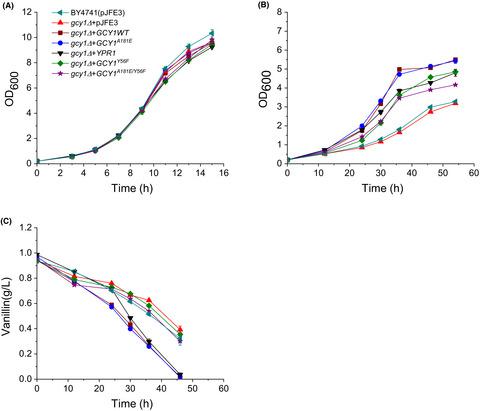当前位置:
X-MOL 学术
›
Microb. Biotechnol.
›
论文详情
Our official English website, www.x-mol.net, welcomes your
feedback! (Note: you will need to create a separate account there.)
Newly identified genes contribute to vanillin tolerance in Saccharomyces cerevisiae
Microbial Biotechnology ( IF 4.8 ) Pub Date : 2020-07-30 , DOI: 10.1111/1751-7915.13643 Zhenzhen Liang 1 , Xinning Wang 1, 2 , Xiaoming Bao 1, 2 , Tiandi Wei 1 , Jin Hou 1 , Weifeng Liu 1 , Yu Shen 1
Microbial Biotechnology ( IF 4.8 ) Pub Date : 2020-07-30 , DOI: 10.1111/1751-7915.13643 Zhenzhen Liang 1 , Xinning Wang 1, 2 , Xiaoming Bao 1, 2 , Tiandi Wei 1 , Jin Hou 1 , Weifeng Liu 1 , Yu Shen 1
Affiliation

|
Exploring the mechanisms of tolerance in microorganisms to vanillin, which is derived from lignin, will benefit the design of robust cell factories that produce biofuels and chemicals using lignocellulosic materials. Our objective was to identify the genes related to vanillin tolerance in Saccharomyces cerevisiae. We investigated the effects on vanillin tolerance of several genes that have site mutations in the highly vanillin‐tolerant strain EMV‐8 compared to its parental line NAN‐27. The results showed that overexpression of GCY1, a gene that encodes an aldo‐keto reductase that also has mRNA‐binding activity, YPR1, a paralog of GCY1 that encodes an aldo‐keto reductase, PEX5, a gene that encodes a peroxisomal membrane signal receptor and MBF1, a gene that encodes a multiprotein bridging factor increase the specific growth rates (μ) by 49%, 41%, 44% and 48 %, respectively, in medium containing 6 mmol l−1 vanillin. Among these gene products, Gcy1p and Ypr1p showed NADPH‐dependent and NAD(P)H‐dependent vanillin reductase activity, respectively. The reductase‐inactive mutant Gcy1pY56F also increased vanillin tolerance in S. cerevisiae, suggesting that other mechanisms exist. Although TRS85 and PEX5, genes for which the mRNAs are binding targets of Gcy1p, were shown to be related to vanillin tolerance, both the mRNA and protein levels of these genes were not changed by overexpression of GCY1. The relationship between the mRNA‐binding activity of Gcy1p and its positive effect on vanillin tolerance is still not clear. Finally, we found that the point mutation D112A in Mbf1p, which disrupts the binding of Mbf1p and the TATA element‐binding protein (TBP), did not decrease the positive effect of Mbf1p on vanillin tolerance. This indicates that the binding of Mbf1p and TBP is not necessary for the positive effect on vanillin tolerance mediated by Mbf1p. We have successfully identified new genes related to vanillin tolerance and provided novel targets that can be used to improve the vanillin tolerance of S. cerevisiae. Moreover, we have extended our understanding of the proteins encoded by these genes.
中文翻译:

新发现的基因有助于酿酒酵母中的香兰素耐受性
探索源自木质素的香草醛对微生物的耐受机制,将有益于设计坚固的细胞工厂,这些工厂使用木质纤维素材料生产生物燃料和化学品。我们的目的是鉴定与酿酒酵母中香兰素耐性有关的基因。我们调查了高度耐香草醛菌株EMV-8与其亲本NAN-27相比具有位点突变的几个基因对香草醛耐受性的影响。结果表明,过度GCY1,即编码醛酮还原酶也具有mRNA的结合活性的基因,YPR1,的旁系同源物GCY1编码的醛-酮还原酶,PEX5编码过氧化物酶体膜信号受体的基因MBF1和编码多蛋白桥接因子的基因MBF1在含6 mmol / L培养基中的比生长率(μ)分别提高49%,41%,44%和48%-1香草醛。在这些基因产物中,Gcy1p和Ypr1p分别显示出NADPH依赖性和NAD(P)H依赖性香草醛还原酶活性。还原酶失活的突变体Gcy1p Y56F也增加了酿酒酵母对香兰素的耐受性,表明存在其他机制。虽然TRS85和PEX5,证明其mRNA是Gcy1p结合靶标的基因与香兰素耐受性有关,这些基因的mRNA和蛋白水平均未因GCY1的过表达而改变。Gcy1p的mRNA结合活性与其对香兰素耐受性的积极作用之间的关系尚不清楚。最后,我们发现Mbf1p中的点突变D112A破坏了Mbf1p与TATA元素结合蛋白(TBP)的结合,并没有降低Mbf1p对香兰素耐受性的积极作用。这表明Mbf1p和TBP的结合对于由Mbf1p介导的对香草醛耐受性的积极作用不是必需的。我们已经成功地鉴定了与香兰素耐性有关的新基因,并提供了可用于提高香兰素耐性的新靶标。酿酒酵母。此外,我们扩展了对这些基因编码的蛋白质的理解。
更新日期:2020-07-30
中文翻译:

新发现的基因有助于酿酒酵母中的香兰素耐受性
探索源自木质素的香草醛对微生物的耐受机制,将有益于设计坚固的细胞工厂,这些工厂使用木质纤维素材料生产生物燃料和化学品。我们的目的是鉴定与酿酒酵母中香兰素耐性有关的基因。我们调查了高度耐香草醛菌株EMV-8与其亲本NAN-27相比具有位点突变的几个基因对香草醛耐受性的影响。结果表明,过度GCY1,即编码醛酮还原酶也具有mRNA的结合活性的基因,YPR1,的旁系同源物GCY1编码的醛-酮还原酶,PEX5编码过氧化物酶体膜信号受体的基因MBF1和编码多蛋白桥接因子的基因MBF1在含6 mmol / L培养基中的比生长率(μ)分别提高49%,41%,44%和48%-1香草醛。在这些基因产物中,Gcy1p和Ypr1p分别显示出NADPH依赖性和NAD(P)H依赖性香草醛还原酶活性。还原酶失活的突变体Gcy1p Y56F也增加了酿酒酵母对香兰素的耐受性,表明存在其他机制。虽然TRS85和PEX5,证明其mRNA是Gcy1p结合靶标的基因与香兰素耐受性有关,这些基因的mRNA和蛋白水平均未因GCY1的过表达而改变。Gcy1p的mRNA结合活性与其对香兰素耐受性的积极作用之间的关系尚不清楚。最后,我们发现Mbf1p中的点突变D112A破坏了Mbf1p与TATA元素结合蛋白(TBP)的结合,并没有降低Mbf1p对香兰素耐受性的积极作用。这表明Mbf1p和TBP的结合对于由Mbf1p介导的对香草醛耐受性的积极作用不是必需的。我们已经成功地鉴定了与香兰素耐性有关的新基因,并提供了可用于提高香兰素耐性的新靶标。酿酒酵母。此外,我们扩展了对这些基因编码的蛋白质的理解。











































 京公网安备 11010802027423号
京公网安备 11010802027423号